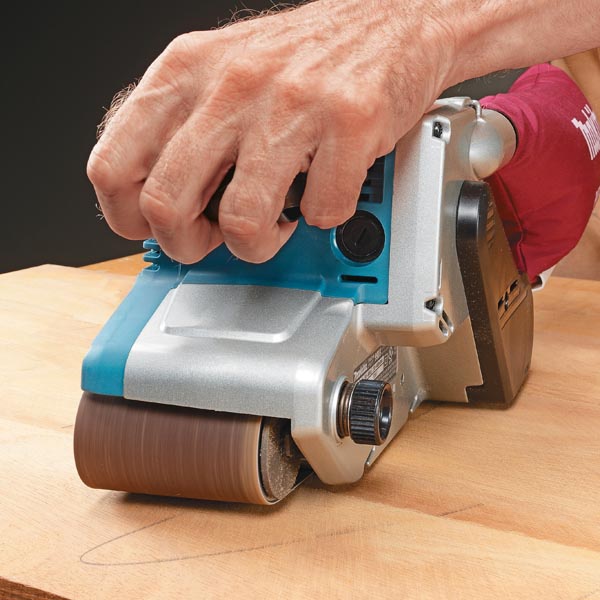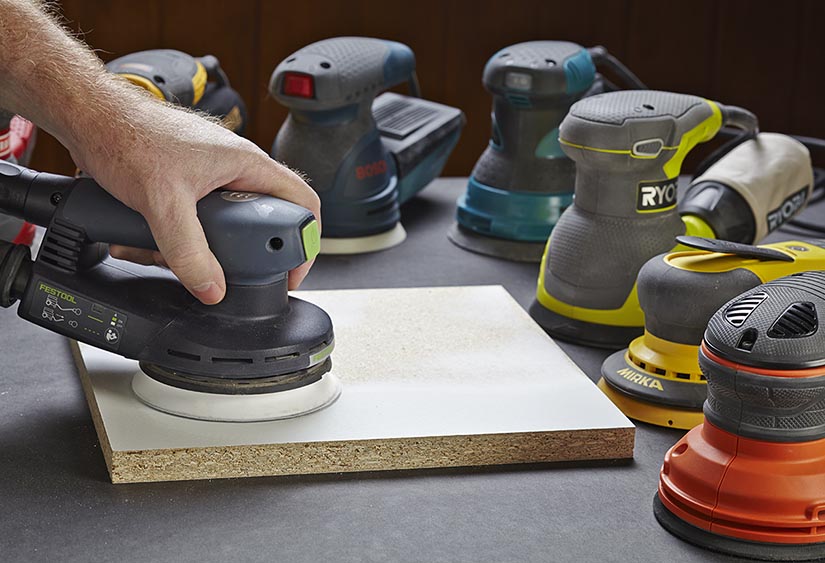Having the right sanding machine can transform rough lumber into a polished masterpiece. Let’s delve into the characteristics of the best sanding machines for wood, evaluating their pros, cons, and best uses, to help you make an informed decision.
Key Takeaways (Best Sanding Machine For Wood):
- Essential features of sanding machines
- Top sanding machines for different uses
- Pros and cons for each sanding machine
- Guidance on pricing and availability
Table of Contents
Overview of Sanding Machines

Sanding machines come in various shapes and sizes, designed for different tasks, from heavy stock removal to fine finishing. Understanding the specific functions can help you select the machine that will best suit your projects.
Details such as motor power, dust collection, and ease of use are significant considerations. But the list doesn’t end here – the type of wood and the level of finish you are aiming for will also influence your choice.
Pros and Cons of Belt Sanders

Belt Sanders are meant for heavy-duty work and are excellent for stripping down rough surfaces quickly.
- Pros:
- Fast material removal
- Can handle large and rough surfaces
- Cons:
- Can be aggressive, leading to gouges if not handled carefully
- Bulkiness can hinder maneuverability
Best used for: Initial stages of sanding, removing paint or varnish, leveling rough lumber.
Orbital Sanders: Ideal for the DIYer

Orbital Sanders, also known as quarter-sheet sanders, use a square or rectangular sandpaper pad that moves in a small circular orbit.
- Pros:
- Versatile, good for a variety of tasks
- Easier to control for a smoother finish
- Cons:
- Not as powerful as belt sanders
- Might struggle with the initial rough sanding
Best used for: Intermediate sanding, preparing surfaces for final finishing.
Random Orbital Sanders: The All-Rounder

Random Orbital Sanders combines the best of both belt and orbital sanders, with a round pad that spins and moves in an orbit.
- Pros:
- Less likely to leave swirl marks
- Suitable for a wide range of materials
- Cons:
- Sandpaper is more expensive
- Not ideal for corner sanding
Best used for Achieving a fine finish on wood, and preparing for paint or varnish.
6 Best Sanding Machines For Wood
When it comes to selecting the best sanding machine for your woodworking needs, we’ve put together a list of top contenders.
All the machines mentioned are readily available for purchase online like Amazon, eBay, and other marketplace, with detailed specifications and customer reviews to guide your choice.
Here are some of the best options on the market:
1. DeWalt Six-Amp Corded Variable Speed Disk Sander

This sander features a five-inch pad and a powerful motor
Specifications:
- Motor: 6 Amp
- Speed: Variable
- Sanding Pad: 5-inch
Best Use:
Ideal for heavy-duty applications and professional use where variable speed is needed for different materials.
- Powerful motor for heavy tasks
- Variable speed for better control
- Durable construction
- Heavier than some competitors, which might lead to fatigue during extended use
- Generally more expensive than entry-level models
Pricing:
Mid to high-range, considering DeWalt’s reputation for professional-grade tools.
2. Makita Five-Inch Random Orbit Sander

This corded three-amp random orbital sander is comfortable and powerful
Specifications:
- Motor: 3 Amp
- Speed: Fixed
- Sanding Pad: 5-inch
Best Use:
Great for furniture makers or DIY enthusiasts who want a balance of power and finesse.
- Comfortable ergonomic design
- Efficient dust collection system
- Well-balanced and less vibration for precision work
- Fixed speed which might limit its use on certain materials
- The dust collection system may require compatible vacuum or bags
Pricing:
Mid-range, reflecting Makita’s reliable performance and quality.
3. Bosch ROS20VSC Random Orbital Sander

This corded sander is versatile and has a comfortable grip
Specifications:
- Motor: 2.5 Amp
- Speed: Variable
- Sanding Pad: 5-inch
- Dual-mode for aggressive sanding as well as regular finishing
- Built-in dust extraction system
Best Use:
A versatile tool ideal for finishing work and precision sanding.
- Variable speed dial to match the speed to the task
- Comfortable grip for extended use
- Effective dust collection
- May lack power for more strenuous tasks
- Relatively short power cord
Pricing:
Mid-range and competitive for its feature set.
4. DeWalt DWE6421 Random Orbital Sander

This corded sander is also versatile and has a powerful motor
Specifications:
- Motor: 3 Amp
- Speed: Single-speed
- Sanding Pad: 5-inch
Best Use:
Excellently suited for professional carpenters and tradespeople who need reliable, long-lasting tools.
- High-performance motor
- Durable and ergonomically designed
- Effective dust-sealed switch
- Single speed may not be suitable for all applications
- Slightly heavier which could impact user fatigue
Pricing:
Mid to high-range, suited for DeWalt’s brand and quality reputation.
5. Ryobi P411 Orbital Sander

This cordless sander is a great value for homeowners
Specifications:
- Motor: Cordless, 18V battery (not included)
- Speed: Single-speed
- Sanding Pad: 5-inch
Best Use:
Ideal for home DIY projects and for users already invested in the Ryobi 18V platform.
- Cordless convenience
- Affordable price point
- Decent performance for the average user
- Battery and charger often sold separately
- Not as powerful as corded counterparts
Pricing:
Lower range, especially appealing if you already own Ryobi 18V batteries and charger.
6. Black+Decker BDEMS600 Sander

This corded sander is a workhorse at a reasonable price and is great for furniture restoration
Specifications:
- Motor: 1.2 Amp
- Speed: Single-speed
- Sanding Pad: Compact size
Best Use:
Best for light DIY work, such as furniture restoration and craft projects.
- Very affordable
- Compact and easy to maneuver
- Versatile with different grip positions
- Less powerful motor
- Durability may not match that of more professional tools
- Dust collection can be subpar compared to rivals
Pricing:
Entry-level and budget-friendly, perfect for casual or occasional use.
When considering which sander to purchase, you’ll want to weigh these factors against what you plan to use the sander for, how often you’ll use it, and what other tools you might need to complement it.
Reading customer reviews and looking at rating averages on retailer and manufacturer websites can also offer a more current and user-based perspective.
Always check for prices across multiple retailers to find the best deal, and consider warranty and customer service reputation as part of your purchasing decision.
Addressing Common Concerns
Working with a sanding machine might raise questions regarding dust management, the right grit sandpaper for various stages of woodworking, and how to maintain these machines for longevity and safety.
Dust collection systems are integral parts of modern sanders, and choosing the correct grit is elaborated in our comprehensive guide to measuring and marking for precision in carpentry tasks.
Price and Availability
The pricing of sanding machines varies widely based on functionality, brand, and additional features. You can generally expect to pay anywhere from $50 for a basic model to upwards of $300 for a professional-grade sander.
Most top brands are sold through home improvement stores and online platforms, offering competitive pricing and accessibility.
Conclusion
In conclusion, the search for the best sanding machine for wood requires attention to the type of work you’ll be doing, comfort and ergonomics, power needs, and, of course, your budget. Whether you opt for a belt, orbital, or random orbital sander, selecting the right machine will enhance your woodworking experience and lead to better-finished products.
Remember to always consult detailed reviews and ratings before purchasing, and refer to our guides on basic carpentry techniques and wood types to ensure that you have all the knowledge necessary to make the most of your sanding machine. Happy woodworking!
FAQs and Additional Guidelines
What is the difference between a belt sander and an orbital sander?
A belt sander uses a continuous loop of sandpaper and is ideal for rapid material removal. An orbital sander uses a square or rectangular pad that moves in small circles, providing a finer finish suitable for intermediate stages of sanding.
Can I use a random orbital sander for detailed work?
Yes, random orbital sanders can be used for detailed work; however, their round pads may not reach into tight corners. Consider a detail sander with a triangular pad for intricate areas.
How do I know what grit sandpaper to use?
Start with a coarser grit for initial material removal and gradually work your way up to finer grits for a smooth finish. For specific grit recommendations, consult our guide on measuring and marking principles.
Are higher-priced sanders always better?
Not necessarily. While higher-priced sanders may offer more features or durability, there are many reliable and efficient sanders available at lower price points. Match the sander to your specific needs and budget.
What should I look for in terms of dust collection?
Look for sanders with built-in dust ports that can connect to shop vacuums or dust extraction systems. This feature is critical for maintaining a clean work environment and reducing health hazards from wood dust.
How do I maintain my sanding machine?
Maintenance typically includes regular cleaning of the dust collection system, checking for worn bearings, replacing sanding pads as needed, and ensuring that moving parts are lubricated according to the manufacturer’s guidelines.
Can sanding machines be used on all types of wood?
Yes, with the proper sandpaper grit and sander type, you can sand most wood types. However, harder woods may require more power and a slower approach. Our article on wood types discusses the properties of different woods in detail.
Is speed variability important in a sanding machine?
Speed variability allows you to adjust the sander’s aggressiveness, which can be especially useful when working with different types of wood or when transitioning from rough sanding to fine finishing.
How do I prevent swirl marks when using a sander?
Using a random orbital sander with variable speed and applying even pressure can help prevent swirl marks. Also, make sure to move the sander at a consistent pace and not linger too long in one spot.
Where is the best place to buy a sanding machine?
Sanding machines can be bought at hardware stores, home improvement centers, and online retailers. Online shopping might provide more reviews and comparisons, which can help in making an informed purchase.
For further details on choosing and using your wood sanding machine, do not hesitate to check out our in-depth FAQ section where we address common concerns. This valuable resource is just a part of the complete knowledge base we offer at Carpentrify, your go-to source for all carpentry essentials.
I'm Joseph Winters, a carpenter, and handyman by trade and a passionate blogger by hobby. I have been in the construction industry for over 10 years, and I've gained an immense amount of knowledge and experience. I'm passionate about sharing my experience and expertise with others, which is why I started Carpentrify.com.







5 Best Scroll Saw for Beginners 2024
Welcome to my blog
Best Countersink Bit for Wood: Pros, Cons and Best Use
Best Sanding Machine For Wood
4 Ways Choosing the Best Wood for Woodworking
Best Sanding Machine For Wood
5 Best Scroll Saw for Beginners 2024
Best Countersink Bit for Wood: Pros, Cons and Best Use